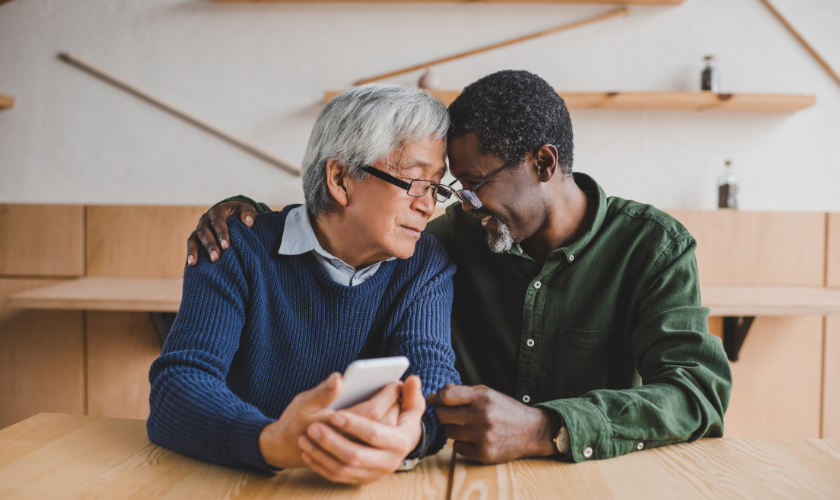Fostering a Safe Space for Our LGBTQ+ Patients and Staff

Everyone receiving palliative care deserves to be treated with dignity and respect. That is no less true for those who identify as LGBTQ+. While many issues and concerns are the same as for heterosexual and/or cisgender patients, it is important to understand some of the unique needs and concerns of LGBTQ+ patients so we can provide the highest quality of medical care.
"It is important to understand some of the unique needs and concerns of LGBTQ+ patients so we can provide the highest quality of medical care."
As a palliative medicine physician who also embodies a multiple minority status as a woman, Asian of Filipino heritage, immigrant, and a woman of transgender experience, I empathize with these needs and concerns. As part of my department’s Diversity, Equity, and Inclusion (DEI) initiative, I work alongside other champions to educate hospital colleagues and peers around the country on the palliative care issues for this community, which require additional attention, sensitivity, and nuance.
It shouldn’t have to take special educational efforts to ensure equity and inclusion, but we can all be subject to misinformation, inherent biases, or stereotyping. LGBTQ+ people have a long history of inequity and discrimination within the health care system. Many providers mean well, but lack the knowledge and/or understanding to respond ideally to this population. As with any other patients, it is important to treat LBGTQ+ patients as individuals, with their own personal history and lived experiences.
"Many providers mean well, but lack the knowledge and/or understanding to respond ideally to this population."
It starts with the electronic medical records (EMR). I’m pleased that the Mount Sinai Health System, where I work, has changed its practice to reflect non-traditional information on sexual orientation and gender identity (SOGI). We no longer automatically assume that every man is married to a woman or that every woman’s partner is a man. Making a concerted effort to standardize the EHR around SOGI will help catalyze the visibility of those patients who identify as LGBTQ+. You cannot address the population if there is no visibility. Unfortunately, some patients at other institutions that are less forward-thinking do not feel comfortable sharing their sexual orientation or gender identity, which can and does affect their care.
LGBTQ+ patients often enter palliative care sicker and with greater mental health needs. Many have avoided routine medical care out of fear of discrimination or judgement by health care providers. LGBTQ+ patients often have significant experiences of victimization within the medical system, due to homophobia, transphobia, and racism, which can negatively impact palliative care. For a long time, their partners or significant others were not allowed to be part of the decision-making process; care choices often reverted back to the nuclear family, regardless of whether the person had good or strained relationships with blood relatives.
The Importance of Listening and Sensitivity
Communication, listening, and empathy are the building blocks for high-quality palliative care for every patient, regardless of SOGI. While it may be difficult for some clinicians to have conversations about gender identity and preferences, they are vital to ensuring the type of care LGBTQ+ patients—like all patients—deserve. It can start with something as basic as introducing yourself, and providing your own pronouns at every new patient encounter. Ask the patient their name and how they want to be addressed—that’s especially vital for transgender and gender non-conforming individuals whose names may be different than what is on their chart or other legal documents. And if you do misgender the person, simply correct yourself, apologize, move on, and make every effort to not make assumptions moving forward.
"While it may be difficult for some clinicians to have conversations about gender identity and preferences, they are vital to ensuring the type of care LGBTQ+ patients—like all patients—deserve."
Then, ask them another critical question, referred to as the dignity question: “What do I need to know about you as a person to take the best care of you that I can?” Some individuals who identify as LGBTQ+ may be willing to disclose who they are right away; some may not, since you are still trying to establish a rapport. But it should not deter you from asking the question. You may find out on subsequent visits, if they trust you, and think you are sincere in your support.
If there are other people in the room, don’t make assumptions about their relations. Ask to be introduced, and ask what the nature of the relationships are. If the patient is alone, ask them who the most important people in their life are, and how they’re related. They could be blood relatives or families of choice.
"Asking permission when doing an examination, especially for transgender and gender non-conforming patients, is not only polite, but shows sensitivity to each individual’s situation.
Asking permission when doing an examination, especially for transgender and gender non-conforming patients, is not only polite, but shows sensitivity to each individual’s situation. Some of us have made changes to our bodies and some have not. Ask whether it’s okay to examine the person; explain what you’re doing and why you’re doing it—listening to the heart and lungs, for example, to figure out if there’s a heart problem. If it’s relevant to examine the genitalia or reproductive organs, ask permission and get their buy-in first. Also ask how they want you to refer to their private parts; some people are sensitive to certain words, and it can trigger dysphoria.
This is where cultural competency training becomes so important. We certainly want to teach providers appropriate language and approach, but we also don’t want them walking on eggshells when they’re taking care of patients. Eventually my hope is that a standardized approach evolves, and it won’t be a big deal; it will be normalized. And become second nature in clinical practice.
"In clinical encounters, providers should be intentional about exploring who the important people are in their patients' lives and to include them in collaborative decision-making after patient consent."
In clinical encounters, providers should be intentional about exploring who the important people are in their patients' lives and to include them in collaborative decision-making after patient consent. When medical decisions are made, it is also critical to share them with the families/caregivers of choice. Documents reflecting preferences for care include living will, health proxy, MOLST/POLST, Five Wishes, or a combination of any of these.
A properly executed advance directive is important for all patients; however, it’s an especially critical step for LGBTQ+ people, particularly if there’s no formal relationship through marriage or domestic partnership. Without legal authority, care decisions may automatically default to biological family members, depending on where you live. Non-judgmental and supportive queries from team members can help the patient document who can make decisions on their behalf if the need arises.
Developing a Supportive Environment
I have seen an evolution at our hospital since my arrival in 2013, after spending several years teaching and practicing in Providence, Rhode Island. I have had personal experiences caring for both of my grandparents, an aunt, and my sister, in their last phases of life. I take pride in my minority status because it is intersectional. I bring all of these dimensions to the table as a clinician. I am fortunate that I was able to blend well during my transition in 2015; this department has really nurtured, embraced, and celebrated me for who I truly am—noticing the merits of my work rather than judging me for my lifestyle or my choices. I never felt for a second that I was treated any differently.
I think that my visibility allowed for representation of the LGBTQ+ community, as well as transgender and gender non-conforming providers. We do exist and are just as capable as any other provider.
Yes, there are still gaps, but we have made huge strides as an institution to incorporate a culture of humility, tolerance, and understanding. We have launched competency training within the health system, including an LGBTQ+ curriculum and cultural competency training at the Icahn School of Medicine. It’s never too late to learn, or to unlearn, misguided ideas about how to take care of our LGBTQ+ patients. It only takes one pebble to create a ripple effect.
For example, the COVID-19 pandemic exposed vulnerabilities in different minority populations. Brown, Black, and Indigenous individuals have been disproportionately affected by COVID-19 because of lack of access to the vaccines, misinformation, lack of financial resources, employment status, and other socioeconomic determinants. If a person also identifies as LGBTQ+, it only adds more stress to what they’re already experiencing due to their minority status. Having that lens of understanding is a key strategy to successfully providing the highest quality of care for the LGBTQ+ community.
Despite the great strides we have made in understanding and caring for the LGBTQ+ populations, there is a need for additional practical resources to help palliative care teams improve care for them. Kimberly Acquaviva’s book, LGBTQ-Inclusive Hospice and Palliative Care, as well as several CAPC resources on health equity and managing implicit bias, are good places to start.
"Visibility and representation should be reflected in our providers as well—those who identify as LGBTQ+ must be emboldened and empowered to celebrate their authentic selves, and be visible and know they are supported."
Providing the best quality care for the LGBTQ+ community requires commitment as an ongoing endeavor. Visibility and representation should be reflected in our providers as well—those who identify as LGBTQ+ must be emboldened and empowered to celebrate their authentic selves, and be visible and know they are supported.
As a provider, as part of a community, and as a patient myself, I don’t expect a sea change overnight. What we’re asking for is to open a window for dialogue, engagement, and respectful interactions. We can always respectfully agree to disagree. Being able to listen to each other and find some common ground or an amicable approach are initial steps towards progress and change.

Be the first to read articles from the field (and beyond), access new resources, and register for upcoming events.
SubscribeEdited by Melissa Baron. Clinical review by Andrew Esch, MD, MBA.
